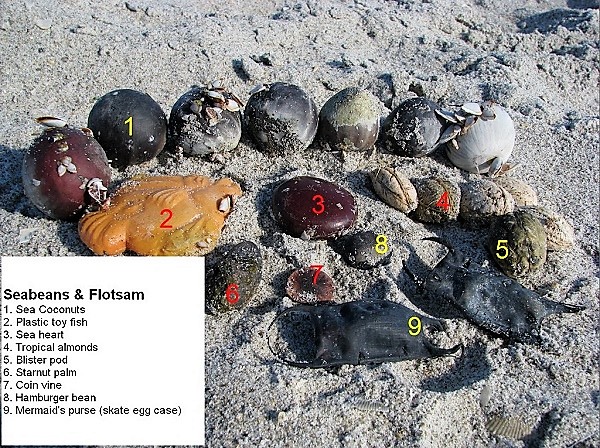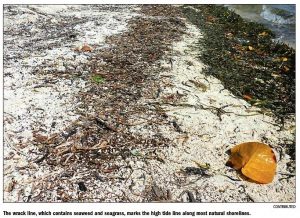A fun pastime on any beach is looking for what’s washed up with the tides. Interesting things can wind up in the beach wrack line — piles of seaweed and seagrass marking the high tide line along most natural shorelines. Depending on where you are in Florida, you may be hunting for shark’s teeth, shells or even long lost sunken treasure. In the Florida Keys, we search for sea beans.
 The Florida Keys shorelines do not have constant wave action due to the coral reefs offshore, so we only find items that float on the currents. Besides plastic garbage, natural items, such as sea beans and pumice rock, can float ashore. Many of these items can travel thousands of miles before washing onto our shorelines.
The Florida Keys shorelines do not have constant wave action due to the coral reefs offshore, so we only find items that float on the currents. Besides plastic garbage, natural items, such as sea beans and pumice rock, can float ashore. Many of these items can travel thousands of miles before washing onto our shorelines.
One of the most exciting finds on a Florida Keys beach is the true sea bean, also called a hamburger bean because it resembles a tiny hamburger. The vine that bears these seeds are native to the forests of the Caribbean islands, Central America and South America. After the seed pods open, the seeds fall into rivers, travel to the ocean and then drift on ocean currents to their new homes. Another favorite sea bean commonly found on Florida Keys shorelines is the sea heart.
This bean is rumored to have sparked Christopher Columbus’ interest in learning about ocean currents and traveling west to find the New World. Collectors also say that finding a sea heart will grant you many years of good luck. Sea hearts come from the Central American vine called “escalera de mono,” which translated means “monkey ladder” vine. This vine gets its name because monkeys commonly use it to travel in the treetops. It also holds the record for the longest seed pods, which can measure up to 6 feet long.
Floating rocks also are a common sight in the wrack line. Pumice stones are rock forms created from lava flows. As the lava cools, the gas in the molten lava becomes trapped and forms pockets of air. This trapped air makes the pumice very buoyant and therefore able to float on ocean currents. As they travel on the ocean currents, pumice stones become rounded and smooth.
 Florida State Parks are an excellent place to search the shoreline for unique finds. Please remember that these natural treasures are fun to look at, but should be left in place so others can also enjoy them. In addition, some beach finds, such as seashells, can become repurposed by nature when washed ashore. Land hermit crabs scour the shorelines for upgrades to their current shells. When beachcombers remove these empty shells from the wrack line, they remove potential housing material that the crabs need to grow.
Florida State Parks are an excellent place to search the shoreline for unique finds. Please remember that these natural treasures are fun to look at, but should be left in place so others can also enjoy them. In addition, some beach finds, such as seashells, can become repurposed by nature when washed ashore. Land hermit crabs scour the shorelines for upgrades to their current shells. When beachcombers remove these empty shells from the wrack line, they remove potential housing material that the crabs need to grow.
The best way to remember your treasure hunt is to snap a picture and leave the treasures behind for someone else to discover. Visit floridastateparks.com to plan your next treasure hunting adventure in “the Real Florida!”
Becky Collins is a park ranger at John Pennekamp Coral Reef State Park.
